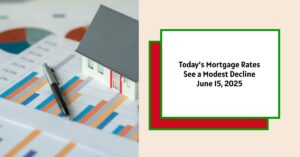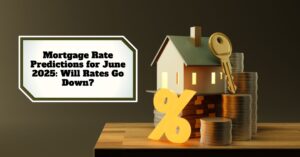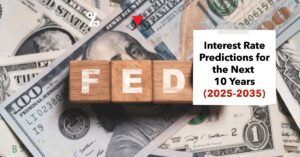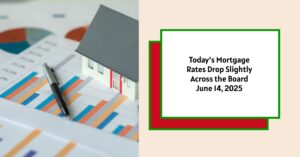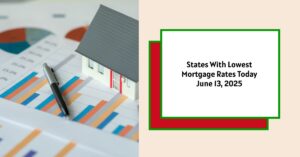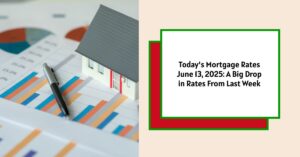Today, June 15, 2025, the national average mortgage rates in the United States reflect a modest reduction from the previous day and last week. The 30-year fixed mortgage rate has decreased to 6.93%, down from 6.94% and 6.99% just a week before. This drop of 1 basis point may seem small, but it could save homeowners considerable money over the life of the loan. Additionally, the 15-year fixed mortgage rate is now at 6.02%, a decrease from 6.03%. However, the 5-year adjustable-rate mortgage (ARM) has seen a rise of 24 basis points, moving up to 7.34% (Zillow).
Today’s Mortgage Rates – June 15, 2025: All the Rates See Modest Decline
Here’s a detailed look at today’s mortgage rates from Zillow:
Conforming Mortgages
Conforming loans are those that conform to the guidelines set by the Federal Housing Finance Agency (FHFA) and are commonly used for home purchases.
| Loan Type | Rate | 1 Week Change | APR | 1 Week Change |
|---|---|---|---|---|
| 30-Year Fixed Rate | 6.93% | down 0.06% | 7.38% | down 0.06% |
| 20-Year Fixed Rate | 6.70% | down 0.13% | 6.97% | down 0.27% |
| 15-Year Fixed Rate | 6.01% | down 0.05% | 6.31% | down 0.05% |
| 10-Year Fixed Rate | 6.03% | up 0.10% | 6.13% | down 0.04% |
| 7-Year ARM | 7.63% | down 0.19% | 8.09% | down 0.14% |
| 5-Year ARM | 7.34% | down 0.28% | 7.91% | down 0.09% |
Government-Backed Mortgages
Government-backed loans, such as FHA and VA loans, often have lower interest rates because they are insured by the government.
| Loan Type | Rate | 1 Week Change | APR | 1 Week Change |
|---|---|---|---|---|
| 30-Year Fixed Rate FHA | 7.02% | up 0.11% | 8.05% | up 0.11% |
| 30-Year Fixed Rate VA | 6.42% | down 0.03% | 6.64% | down 0.02% |
| 15-Year Fixed Rate FHA | 5.75% | up 0.06% | 6.72% | up 0.04% |
| 15-Year Fixed Rate VA | 5.91% | down 0.07% | 6.26% | down 0.06% |
Jumbo Loans
Jumbo loans are for amounts above the conforming loan limits and usually have higher rates.
| Loan Type | Rate | 1 Week Change | APR | 1 Week Change |
|---|---|---|---|---|
| 30-Year Fixed Rate Jumbo | 7.40% | down 0.02% | 7.86% | up 0.05% |
| 15-Year Fixed Rate Jumbo | 6.51% | down 0.25% | 6.82% | down 0.20% |
| 7-Year ARM Jumbo | 7.53% | 0.00% | 8.06% | 0.00% |
| 5-Year ARM Jumbo | 8.17% | up 0.49% | 8.47% | up 0.42% |
Current Refinance Mortgage Rates as of June 15, 2025
According to Zillow, the current average 30-year fixed refinance rate fell 4 basis points from 7.15% to 7.11% on Sunday, Zillow announced. The 30-year fixed refinance rate on June 15, 2025 is down 11 basis points from the previous week's average rate of 7.22%. Additionally, the current national average 15-year fixed refinance rate increased 3 basis points from 6.03% to 6.06%. The current national average 5-year ARM refinance rate is equal to 5.94%.
Conforming Loans
| Loan Type | Rate | 1 Week Change | APR | 1 Week Change |
|---|---|---|---|---|
| 30-Year Fixed Rate | 6.93% | down 0.06% | 7.38% | down 0.07% |
| 20-Year Fixed Rate | 6.70% | down 0.13% | 6.97% | down 0.27% |
| 15-Year Fixed Rate | 6.02% | down 0.05% | 6.31% | down 0.06% |
| 10-Year Fixed Rate | 6.03% | up 0.10% | 6.13% | down 0.04% |
| 7-Year ARM | 7.63% | down 0.19% | 8.09% | down 0.14% |
| 5-Year ARM | 7.15% | down 0.47% | 7.75% | down 0.25% |
| 3-Year ARM | — | 0.00% | — | 0.00% |
Government Loans
| Loan Type | Rate | 1 Week Change | APR | 1 Week Change |
|---|---|---|---|---|
| 30-Year Fixed Rate FHA | 6.38% | down 0.32% | 7.39% | down 0.33% |
| 30-Year Fixed Rate VA | 6.56% | down 0.02% | 6.78% | 0.00% |
| 15-Year Fixed Rate FHA | 6.00% | up 0.25% | 6.97% | up 0.23% |
| 15-Year Fixed Rate VA | 5.97% | down 0.02% | 6.33% | up 0.03% |
How to Get the Best Mortgage Rate in 2025
Finding the best mortgage rate takes a bit of effort, but the following strategies can help potential borrowers secure a favorable rate:
- Improve Your Credit Score: Your credit score significantly impacts your mortgage rate. Lenders reward borrowers with higher scores with lower rates. Focus on paying off outstanding debts, making timely payments, and avoiding new debt.
- Shop Around: Don’t settle for the first mortgage quote you receive. Different lenders can offer different rates based on their criteria and market conditions. Research and compare rates from banks, credit unions, and online lenders.
- Consider Multiple Loan Types: Not all loans are created equal. Some loans like USDA and FHA may offer lower rates compared to conventional loans. Assess the costs and benefits of each type based on your financial situation.
- Pay Attention to Loan Points: Loan points are pre-paid interest that can lower your monthly payments. Paying points upfront can be beneficial if you plan to stay in your home long enough to recoup the expense.
- Lock in Your Rate: Many lenders offer the option to lock in your rate for a specified period. If you find a particularly favorable rate, locking it in can protect you against market fluctuations.
- Provide a Larger Down Payment: Offering a larger down payment can often result in better interest rates. Lenders see borrowers with a lower loan-to-value ratio as less risky, which can lead to better rates.
- Document Your Income Accurately: Showing solid income can put you in a better position to negotiate rates. Ensure that you have all necessary documentation to prove your financial stability.
When Should You Refinance Your Mortgage?
Refinancing can be a strategic move for homeowners, but it should be a well-considered decision:
- Lowering Monthly Payments: If current interest rates are significantly lower than your existing loan, refinancing could reduce your monthly payment, stretching your budget further.
- Switching from ARM to Fixed Rate: If you have an adjustable-rate mortgage and wish for the predictability of fixed payments, refinancing might be the right choice to secure those lower fixed rates.
- Accessing Home Equity: Many homeowners choose to refinance to cash out on some equity. This equity can be used for renovations, education, or consolidating debt, which can ultimately create greater financial stability.
- Shortening Loan Term: For those who can afford higher payments, refinancing to a shorter mortgage term allows you to pay off your home faster and save on overall interest.
Are Refinance Rates the Same as Mortgage Rates?
Refinance rates and primary mortgage rates are closely related but can differ based on a variety of factors, including:
- Loan Type: Refinance loans, especially if cash-out, might carry different risk qualities compared to initial purchase loans.
- Current Market Conditions: Interest rate dynamics can shift based on economic factors. Refinance rates can move differently than general mortgage rates due to market nuances.
- Borrower’s Profile: The mix of existing loan balances and the borrower’s creditworthiness plays a role, often resulting in higher refinance rates compared to new mortgage rates.
It’s advisable for homeowners considering refinancing to consult with multiple lenders to understand specific rates tailored to their unique profiles.
Read More:
Mortgage Rates Trends as of June 14, 2025
Will Mortgage Rates Go Down Below 6% in 2025?
Forecasts suggest that while mortgage rates may trend downward over the next year, significant drops below 6% might not occur. According to Fannie Mae, rates are projected to stabilize at 6.1% by the end of 2025 and fall further to 5.8% in 2026 (Fannie Mae, 2025). Similarly, the Mortgage Bankers Association anticipates that rate fluctuations will keep rates near 6.7% through September before tapering slightly down to 6.6% at the close of the year (Freddie Mac, 2025).
This information suggests that while there's the potential for slight reductions in rates, buyers and homeowners should not expect a return to the historic lows seen in past years. As market conditions continue to stabilize, it may be prudent to make preparations for either purchasing or refinancing before rates settle in at those slightly elevated levels.
Further Insights into the Mortgage Market
Key Economic Factors Affecting Mortgage Rates
Multiple factors can influence the mortgage market, including:
- Federal Reserve Policies: The strategies employed by the Federal Reserve regarding interest rates play a critical role in shaping mortgage rates. If the Fed raises its benchmark rate, mortgage rates may rise as lenders pass on those costs to borrowers.
- Inflation Rates: When inflation rises, there is a potential increase in interest rates, leading to higher mortgage costs. Conversely, low inflation could lead to reduced rates.
- Employment Rates: A strong job market tends to support economic growth and can contribute to rising interest rates, while a weaker job market may lead to lower rates as lenders become more competitive.
- Consumer Confidence: A bullish consumer sentiment can lead to increased demand for home purchases, driving rates up due to high application volumes. In contrast, during economic downturns, rates may soften to stimulate borrowing.
Bottom Line:
In summary, understanding today’s mortgage rates and how they affect financial decisions is crucial for anyone looking to buy or refinance a home. On June 15, 2025, the mortgage landscape shows a mix of slight decreases and increases, emphasizing the need for homebuyers and homeowners to remain vigilant and informed.
By improving your credit score, shopping around for the best rates, and considering the appropriate loan type for your financial situation, you can secure the most favorable mortgage conditions. Additionally, weighing the advantages of refinancing can lead to significant savings and better financial management down the road.
Invest Smarter in a High-Rate Environment
With mortgage rates remaining elevated this year, it's more important than ever to focus on cash-flowing investment properties in strong rental markets.
Norada helps investors like you identify turnkey real estate deals that deliver predictable returns—even when borrowing costs are high.
HOT NEW LISTINGS JUST ADDED!
Connect with a Norada investment counselor today (No Obligation):
(800) 611-3060
Also Read:
- Will Mortgage Rates Go Down in 2025: Morgan Stanley's Forecast
- Expect High Mortgage Rates Until 2026: Fannie Mae's 2-Year Forecast
- Mortgage Rate Predictions 2025 from 4 Leading Housing Experts
- Mortgage Rates Forecast for the Next 3 Years: 2025 to 2027
- 30-Year Mortgage Rate Forecast for the Next 5 Years
- 15-Year Mortgage Rate Forecast for the Next 5 Years
- Why Are Mortgage Rates Going Up in 2025: Will Rates Drop?
- Why Are Mortgage Rates So High and Predictions for 2025
- Will Mortgage Rates Ever Be 3% Again in the Future?
- Mortgage Rates Predictions for Next 2 Years
- Mortgage Rate Predictions for Next 5 Years
- Mortgage Rate Predictions: Why 2% and 3% Rates are Out of Reach
- How Lower Mortgage Rates Can Save You Thousands?
- How to Get a Low Mortgage Interest Rate?
- Will Mortgage Rates Ever Be 4% Again?
